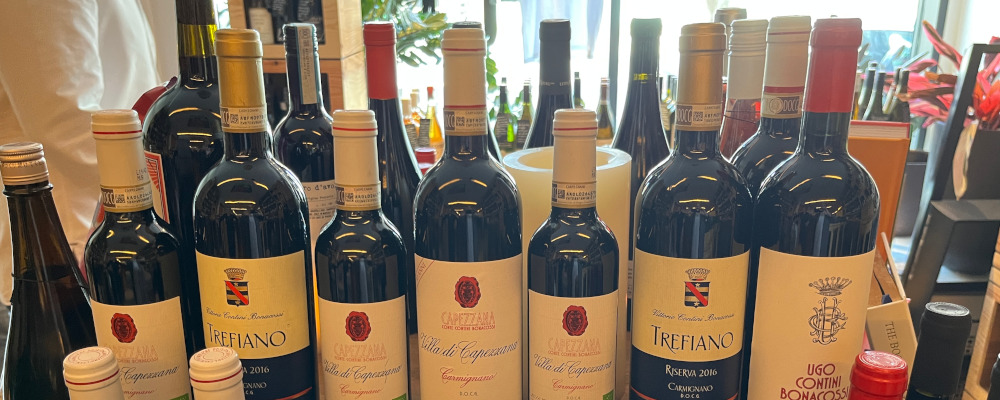What’s the point of wine writing? By which I mean, what’s the point of reading wine writing? It’s something I do every day, but I’m not sure with purpose, other than a vague sense of looking for something “interesting”, whatever that means, and to see generally what others are writing about.
Is the point to find the latest trend? In the wine world, that’s not as hard as it is in other realms of human creativity. Wine fashion moves slowly, with one vintage per year, and often three or five years for newly planted vines to produce serviceable fruit.
Is the point to buck the latest trends, and run in the opposite direction of the madding crowd in search of undiscovered gems or ones that have passed from fashion and ought to be rediscovered? I lean towards this answer. There is so much wine out there, it’s good to be reminded of some old favourites, like listening to an old album after many years.
In any event, I was looking for an interesting story about a wine I hadn’t thought about for a few years last week when I met Pierpaulo Guerra for a quick tasting at Loop Line Wine and Food in Toronto. Guerra, who looks to be in his late twenties, is the export manager for Capezzana.
Tenuta Capezzana is an estate just outside of Florence, where they have been making wine for a very long time. The Carmignano Hills, on which the estate rests and from which you can see the Duomo in the old city below, is also the name of the DOCG for the red wines made there. The appellation is small by Tuscan standards and Capezzana is the largest producer and makes most of the wine.
Carmignano wines were first given official sanction in 1716 by Grand Duke Cosimo III de Medici, though there is reference to wine growing there as early as the ninth century. The Capezzana estate is a tourist attraction, with a B&B and seasonal restaurant, and these are impressive dates, but it’s the modern history of the Contini Bonacossi family, which acquired it in 1926, and Carmignano DOCG that makes the wines particularly interesting.
Carmignano was restored to its own appellation status in the 1970s. The patriarch of the Capazzana estate at the time, Ugo Contini Bonacossi had revived winemaking in a serious way and was instrumental in re-establishing Carmignano independently from neighbouring Chianti. He’d also just established Cabernet Sauvignon vines, grafted from no less a prestigious source than Bordeaux’s Château Lafite Rothschild.
When Carmignano got its DOC status in 1975, to be upgraded to DOCG in 1990, it became the only Tuscan appellation that actually requires the inclusion of Cabernet Sauvignon in the blend (up to 20 percent). In an age when so-called indigenous grapes are the height of fashion, not least of all in Italy where they claim more than 400 of them, and when the producers of Chianti Classico continue to limit the amount of “international varieties” in their classified wines, Capezzana’s Carmignanos are happy to buck the trend.
Pierpaolo Guerra sticks to the Carmignano party line when it comes to explaining why Cabernet should be home in Central Italy: Catherine de Medici. Bill Buford’s 2020 memoir Dirt includes an amusing story thread about the Italo-Gallic debate about whether de Medici, who married the King of France in 1547, invented French cuisine. The theory that her court brought Cabernet to Italian winemakers could be France’s revenge.
Whatever happened in the sixteenth century, in the 1970s Bordeaux varieties like Cabernet Sauvignon, Cabernet Franc, and Merlot seemed like the future of Italian wine. One of Tuscany’s first families of wine, the Antinoris, had established one of the first Super Tuscan, Tignanello in 1971. English-speaking export markets were attracted to wines made with Cabernet Sauvignon due to either sentimentality for the great wines of Bordeaux’s last bank, the growing demand for California fine wines, or both.
The Super Tuscans are as popular as ever, but they’ve always stood outside the “classic” wines of the region. The contrarian in me liked that Capezzana and the other Carmignano wineries decided to co-opt what they liked into their tradition. I also remembered quite liking the wines.
My memory was proven true when we tasted the first wine: 2020 Capezzana Barco Reale di Carmignano DOC. Barco Reale (“Royal Park”) is the appellation for wines made in the region that are not aged before release, and are meant to be drunk relatively soon thereafter.
The 2020 is made up of 75 percent Sangiovese, 15 percent Cabernet Sauvignon, 5 percent Cabernet Franc, and 5 percent Canaiolo. This was an unforward, friendly, and classically Mediterranean wine, with dark cherry from the Sangiovese and a touch of black fruit from the Cabs.

When we moved on to the more serious Villa di Capezzana Carmignano DOCG red, Guerra presented two bottles. They were both from this year’s release, but from the 2019 and 2013 vintages, respectively. Some years ago, Capezzana had decided to hold back a few thousand bottles of their flagship Carmignano to be released ten years after harvest as a Riserva.
The Villa di Capezzana is 80 percent Sangiovese and 20 percent Cabernet Sauvignon. Between the 2019 and the 2013 10 Anti Riserva, the remarkable thing was how similar they were despite a difference of six years of ageing. More Sangiovese dark cherry, but also a note of Cabernet cassis. Tannins had softened somewhat in the 2013, but were firm in both.
The 2016 Capezzana Villa Trefiano Carmignano Riserva DOCG is sourced from a single hillside vineyard at 300m above sea level. It’s a blend of Sangiovese, Cabernet Sauvignon, and Canaiolo. Only 1,200 bottles are made, and it was singing with dark red to black fruits and silky tannins, a wine to be paused over. This wine was first made in 1979, and the 40th anniversary 2019 vintage will be released in Canada shortly.
The 2018 UCB Ugo Contini Bonacossi is a single vineyard 100 percent Sangiovese wine that Capezzana makes only a few thousand bottles of every year. The high irony is that it isn’t a Carmignano DOCG, but rather a lowly I.G.T. table wine since it has no Cabernet Sauvignon. No matter, as it’s delicious with a clean, deep, and dark cherry note.
One thing Capezzana is on, or even ahead of trend, is its website. It includes a virtual tour of their cellars and vineyards art.




